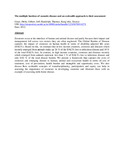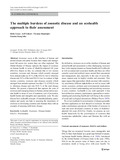| dc.description.abstract | Zoonoses occur at the interface of human and animal disease and partly because their impact and management fall across two sectors they are often neglected. The Global Burden of Disease captures the impact of zoonoses on human health in terms of disability-adjusted life years (DALYs). Based on this, we estimate that in low income countries, zoonoses and diseases which recently emerged from animals make up 26 % of the DALYs lost to infectious disease and 10 % of the total DALYs lost. In contrast, in high
income countries, zoonoses and diseases recently which emerged from animals represent less than 1 % of DALYs lost to infectious disease and only 0.02 % of the total disease burden. We present a framework that captures the costs of zoonoses and emerging disease to human, animal and ecosystem health in terms of cost of treatment, cost of prevention, health burden and intangible and opportunity costs. We also
discuss how ecohealth concepts of transdisciplinarity, participation and equity can help in assessing the importance of zoonoses in developing countries and illustrate these with an
example of assessing milk-borne disease. | en |


